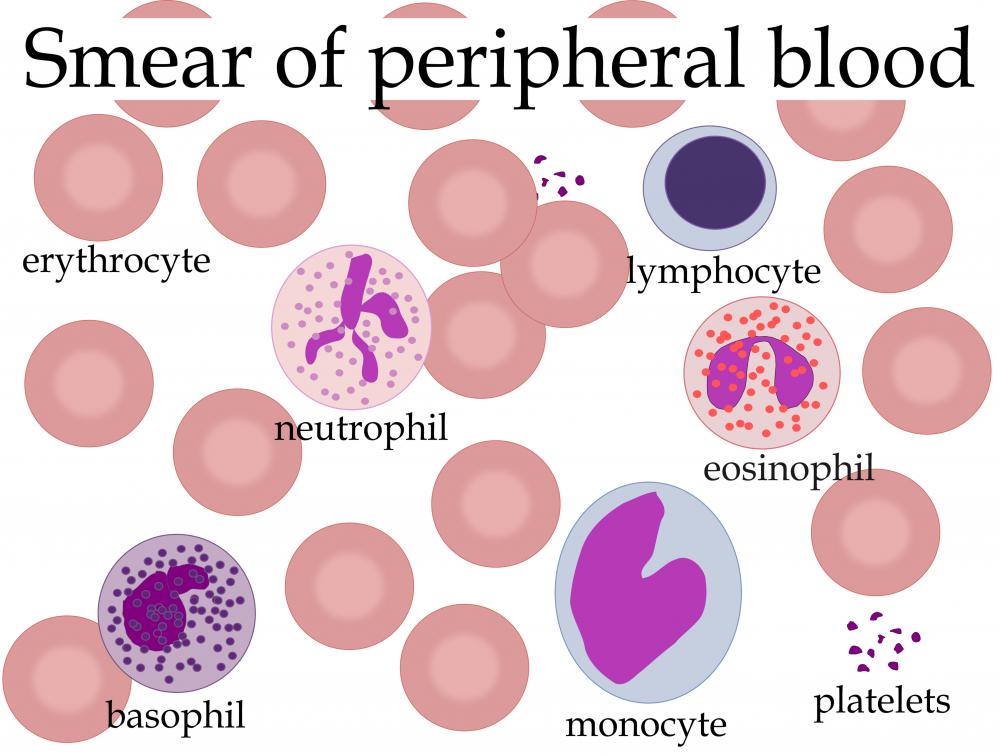At WiseGEEK, we're committed to delivering accurate, trustworthy information. Our expert-authored content is rigorously fact-checked and sourced from credible authorities. Discover how we uphold the highest standards in providing you with reliable knowledge.
What is Eosinophilic?
The term "eosinophilic" is an adjective used to describe a wide range of disorders characterized by high eosinophil counts. Eosinophils are a type of white blood cell used to help fight certain infections and health problems, including allergies and parasites. In some patients, eosinophil counts are higher than they should be with no apparent cause. This usually indicates an eosinophilic disorder, or eosinophilia. Eosinophilia is defined as the state of having more than 500 eosinophils per cubic millimeters of peripheral blood.
There are several causes for elevated eosinophils. Food and environmental allergies are very common causes for high eosinophils. Asthma, allergic rhinitis, atopic dermatitis, drug reactions, milk-protein allergy and urticaria are commonly associated with high eosinophil counts. Infections caused by certain tissue-invasive parasites also contribute to high levels. Tumors and certain cancers also can explain eosinophilia.

Outside of a coexisting illness or disorder, certain disorders are characterized by an elevated eosinophil count in certain areas of the body. For example, Eosinophilic esophagitis (EE) is an allergic inflammation in the esophagus associated with high eosinophil counts in the area. Eosinophils persist despite acid-blocking medication and other standard treatments for esophagitis. Patients with EE actually can sustain injury to the tissue in their esophagus from the eosinophil accumulation. Food allergy or intolerance might be a cause of EE, and the elimination of food proteins from EE patients' diets has shown to be a promising treatment.

Similarly, eosinophilic gastroenteritis (EGE) is a rare, chronic disorder characterized by the accumulation of eosinophils in the gastrointestinal tract that presents with many unpleasant symptoms. Pain, cramping, vomiting, diarrhea and blockages make this disorder difficult for those suffering through it. Symptoms tend to wax and wane over time, and with proper diet and treatment, promise of remission is hopeful. It is possible for pediatric patients with EGE to present with related failure to thrive, growth retardation, amenorrhea or delayed pubery.

Eosinophilic fasciitis, also known as Shulman's syndrome, is another eosinophilic disorder. Shulman's syndrome is a skin disease in which the skin and the fascia underneath become inflamed and thickened, sometimes in addition to warmth, redness and hardening of the skin surface. This disorder sometimes follows a period of high physical exertion, but it also can be associated with certain cancers.

These and other eosinophilic disorders appear to be more prevalent in males as well as people of the caucasian and Asian races. Exact causes and long-term prognoses have been the subject of study and debate. There has been an increase in the diagnoses of the disorders, but whether this is a result of an increase in occurrence or better diagnostic practices has been questioned.
AS FEATURED ON:
AS FEATURED ON:


















Discuss this Article
Post your comments